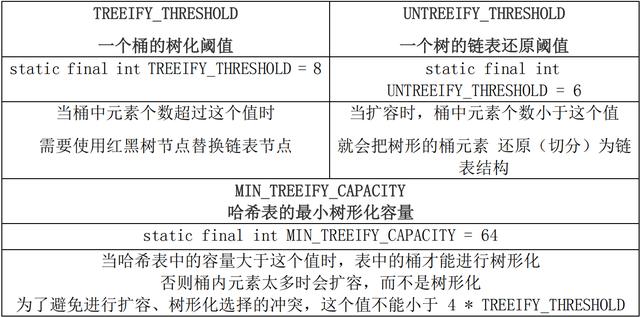目录
- ArrayList
- Vector
- LinkedList
- HashMap
- Hashtable
ArrayList
数据结构:数组
transient Object[] elementData; // non-private to simplify nested class access 空参构造函数创建的是一个空数组,当 add 一个元素时,才初始化容量为 DEFAULT_ capacity = 10。
扩容:默认每次扩容1.5倍
private void grow(int minCapacity) {
// overflow-conscious code
int oldCapacity = elementData.length;
// 默认每次扩容1.5倍
int newCapacity = oldCapacity + (oldCapacity >> 1);
if (newCapacity - minCapacity < 0)
newCapacity = minCapacity;
if (newCapacity - MAX_ARRAY_SIZE > 0)
newCapacity = hugeCapacity(minCapacity);
// minCapacity is usually close to size, so this is a win:
elementData = Arrays. copy Of(elementData, newCapacity);
} Vector
数据结构:数组
protected Object[] elementData;
public Vector() {
this(10);
} 空参构造函数默认创建容量10
扩容:默认对旧容量翻倍
private void grow(int minCapacity) {
// overflow-conscious code
int oldCapacity = elementData.length;
// 容量翻倍
int newCapacity = oldCapacity + ((capacityIncrement > 0) ?
capacityIncrement : oldCapacity);
if (newCapacity - minCapacity < 0)
newCapacity = minCapacity;
if (newCapacity - MAX_ARRAY_SIZE > 0)
newCapacity = hugeCapacity(minCapacity);
elementData = Arrays.copyOf(elementData, newCapacity);
}
LinkedList
数据结构:双向 链表
// 指向双向链表的头和尾
transient Node<E> first;
transient Node<E> last;
// 静态内部类
private static class Node<E> {
E item;
Node<E> next;
Node<E> prev;
Node(Node<E> prev, E element, Node<E> next) {
this.item = element;
this.next = next;
this.prev = prev;
}
} HashMap
数据结构:数组+链表+ 红黑树
// 数组
transient Node<K,V>[] table;
// 链表
static class Node<K,V> implements Map.Entry<K,V> {
// 存储 key 的哈希值
final int hash;
final K key;
V value;
Node<K,V> next;
// ...
}
// 红黑树
static final class TreeNode<K,V> extends LinkedHashMap.Entry<K,V> {
TreeNode<K,V> parent; // red-black tree links
TreeNode<K,V> left;
TreeNode<K,V> right;
TreeNode<K,V> prev; // needed to unlink next upon deletion
boolean red;
TreeNode(int hash, K key, V val, Node<K,V> next) {
super( hash , key, val, next);
}
// ...
} 扩容:旧容量翻倍,见 resize 方法。
参数:扩容、链表与红黑树互转
//默认的初始容量为 16
static final int DEFAULT_INITIAL_CAPACITY = 1 << 4;
//最大的容量上限为 2^30
static final int MAXIMUM_CAPACITY = 1 << 30;
//默认的负载因子为 0.75
static final float DEFAULT_LOAD_FACTOR = 0.75f;
//变成树型结构的临界值为 8
static final int TREEIFY_THRESHOLD = 8;
//恢复链式结构的临界值为 6
static final int UNTREEIFY_THRESHOLD = 6;
// 哈希表 中键值对的个数
transient int size;
//哈希表被修改的次数
transient int modCount;
//它是通过 capacity*load factor 计算出来的,当 size 到达这个值时,就会进行扩容操作
int threshold;
//负载因子
final float loadFactor;
//当哈希表的大小超过这个 阈值 ,才会把链式结构转化成树型结构,否则仅采取扩容来尝试减少冲突
static final int MIN_TREEIFY_CAPACITY = 64; HashMap 关于红黑树的三个关键参数

方法解析
- hash 方法:计算 key 的哈希值
static final int hash(Object key) {
int h;
return (key == null) ? 0 : (h = key.hashCode()) ^ (h >>> 16);
} 这个 hash 方法先通过 key 的 hashCode 方法获取一个哈希值,再拿这个哈希值与它的高 16 位的哈希值做一个异或操作来得到最后的哈希值。
为啥要这样做呢?注释中是这样解释的:如果当 n 很小,假设为 64 的话,那么 n-1即为 63(0x111111),这样的值跟 hashCode()直接做与操作,实际上只使用了哈希值的后 6 位。如果当哈希值的高位变化很大,低位变化很小,这样就很容易造成冲突了,所以这里把高低位都利用起来,从而解决了这个问题。
- tableSizeFor 方法
把 cap 变成第一个大于等于 2 的幂次方的数。例如,16 还是 16,13 就会调整为 16,17 就会调整为 32。
static final int tableSizeFor(int cap) {
int n = cap - 1;
n |= n >>> 1;
n |= n >>> 2;
n |= n >>> 4;
n |= n >>> 8;
n |= n >>> 16;
return (n < 0) ? 1 : (n >= MAXIMUM_CAPACITY) ? MAXIMUM_CAPACITY : n + 1;
} - resize 方法
HashMap 在进行扩容时,使用的 rehash 方式非常巧妙,因为每次扩容都是翻倍,与原来计算(n-1)&hash 的结果相比,只是多了一个 bit 位,所以节点要么就在原来的位置,要么就被分配到“原位置+旧容量”这个位置。
例如,原来的容量为 32,那么应该拿 hash 跟 31(0x11111)做与操作;在扩容扩到了 64 的容量之后,应该拿 hash 跟 63(0x111111)做与操作。新容量跟原来相比只是多了一个 bit 位,假设原来的位置在 23,那么当新增的那个 bit 位的计算结果为 0时,那么该节点还是在 23;相反,计算结果为 1 时,则该节点会被分配到 23+31 的桶上。正是因为这样巧妙的 rehash 方式,保证了 rehash 之后每个桶上的节点数必定小于等于原来桶上的节点数,即保证了 rehash 之后不会出现更严重的冲突。
Hashtable
数据结构:数组+链表
private transient Entry<?,?>[] table;
private static class Entry<K,V> implements Map.Entry<K,V> {
final int hash;
final K key;
V value;
Entry<K,V> next;
// ...
} key 和 value 都不能是 null
public synchronized V put(K key, V value) {
// value 不能是 null
if (value == null) {
throw new NullPointerException();
}
// Makes sure the key is not already in the hashtable.
Entry<?,?> tab[] = table;
// key 不能是 null
int hash = key.hashCode();
int index = (hash & 0x7FFFFFFF) % tab.length;
@SuppressWarnings("unchecked")
Entry<K,V> entry = (Entry<K,V>)tab[index];
for(; entry != null ; entry = entry.next) {
if ((entry.hash == hash) && entry.key.equals(key)) {
V old = entry.value;
entry.value = value;
return old;
}
}
addEntry(hash, key, value, index);
return null;
} 扩容:翻倍+1
protected void rehash() {
int oldCapacity = table.length;
Entry<?,?>[] oldMap = table;
// 翻倍+1
int newCapacity = (oldCapacity << 1) + 1;
if (newCapacity - MAX_ARRAY_SIZE > 0) {
if (oldCapacity == MAX_ARRAY_SIZE)
// Keep running with MAX_ARRAY_SIZE buckets
return;
newCapacity = MAX_ARRAY_SIZE;
}
Entry<?,?>[] newMap = new Entry<?,?>[newCapacity];
modCount++;
threshold = (int)Math.min(newCapacity * loadFactor, MAX_ARRAY_SIZE + 1);
table = newMap;
for (int i = oldCapacity ; i-- > 0 ;) {
for (Entry<K,V> old = (Entry<K,V>)oldMap[i] ; old != null ; ) {
Entry<K,V> e = old;
old = old.next;
int index = (e.hash & 0x7FFFFFFF) % newCapacity;
e.next = (Entry<K,V>)newMap[index];
newMap[index] = e;
}
}
} 

